Democrats And Industry Are At War With Themselves Over A Controversial Energy Plan
- Oops!Something went wrong.Please try again later.
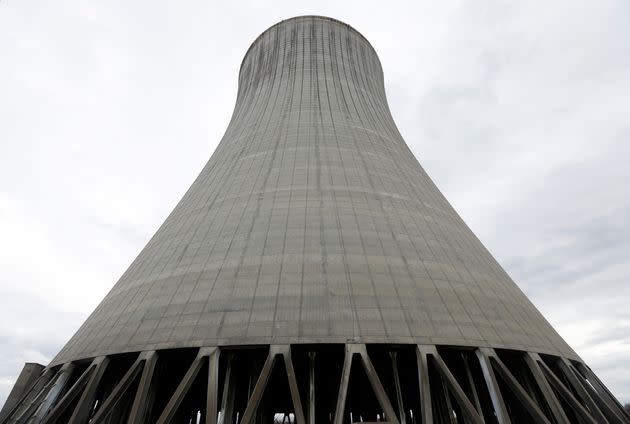
A cooling tower at Nine Mile Point nuclear power plant in Oswego, New York.
OSWEGO, N.Y. — On the snowy eastern shore of Lake Ontario sits a beige metal shipping container roughly the size of a mobile home. Inside, a machine called an electrolyzer is zapping tanks of freshwater with enough volts to split the hydrogen out of H2O to harvest the gas, which the U.S. government is banking on replacing fossil fuels.
Hydrogen, the lightest and most abundant element in the universe, has long been manufactured for use in fertilizers and oil refining. Virtually all the global supply today is produced through a chemical process that strips the hydrogen out of natural gas. Since hydrogen produces only water when burned, making the fuel instead with water and electricity that comes from a zero-carbon source offers something that functions like oil and gas without adding carbon dioxide to the atmosphere.
The trouble is that making hydrogen from electricity still generates far fewer molecules than using natural gas, making the clean stuff much more expensive. The industry uses a color scheme to describe how different types of hydrogen are made: “Gray” hydrogen costs less than $3 per kilogram to produce today, and sometimes drops below $1. The price of “blue” hydrogen, which uses that same fossil method but captures the planet-heating carbon dioxide before it enters the atmosphere, maxes out below $5 and can be less than $2. The “green” hydrogen needed to make a difference on climate change can go for as much as $12, and costs more than gray in every market that analysts surveyed this year.
That’s why the Joe Biden administration is spending billions of dollars to build a whole new American hydrogen industry from the ground up, and bring the price of green hydrogen down to $1 by the end of the decade. The president’s Bipartisan Infrastructure Law set up eight regional hubs across the country to develop hydrogen industrial clusters. Meanwhile, the most lucrative subsidies in the Inflation Reduction Act, or IRA — Biden’s landmark climate spending law — offer companies that make hydrogen with clean electricity a $3 per kilogram write-off.
It looked like a windfall to the United States’ ailing nuclear power industry, whose shrinking fleet of reactors is increasing in value as the country struggles to meet electricity demands and provide a 24-hour supply of zero-carbon power without the fluctuations innate to wind and solar energy. Late last year, Constellation, the biggest U.S. nuclear plant operator, began work with the federal government on a pilot project to generate clean hydrogen from its two reactors at Nine Mile Point Nuclear Station here in the rural lakeside college town in northwestern New York.
Hailed by the Energy Department as a historic “milestone,” it was to be the nation’s first-ever experiment in producing hydrogen from nuclear power — and, according to Constellation, the only major commercial effort in the world.
By March, the electrolyzer’s hum was vibrating the corrugated walls of its shipping container in a fenced-off area outside the nuclear plant’s main facility, pulling power from the reactors. While the company declined to provide a dollar figure, Constellation said its homemade fuel was cheap enough for the power plant here to stop buying the hydrogen it uses in its own reactors from outside vendors, and made plans to keep the electrolyzer going permanently. Looking beyond its own facility, the company started working with the state energy agency in Albany to produce more hydrogen to help keep New York’s lights on.
Constellation now wants to go nationwide with its hydrogen. The Baltimore-based utility giant announced a $900 million investment to build thousands of times as much electrolyzer horsepower at its LaSalle nuclear station in Illinois. In October, the White House gave the company its blessing.
All those plans may go up in flames as early as this week.
That’s when the Treasury Department is expected to release its proposed rules for how companies can qualify for the clean-hydrogen tax credit, known as 45V.
It may turn out to be among the Biden administration’s most consequential — and controversial — climate policy decisions.
The debate — and resulting lobbying war — center on whether companies need to build new power plants to guarantee that hydrogen is, in fact, clean and not just cannibalizing the grid’s supply of zero-carbon electricity, driving demand to keep fossil fuel stations going.
Among those who say hydrogen is only clean if it comes from new green sources of electricity are the European Union, the world’s biggest hydrogen-maker, environmentalists and climate hawks like Sen. Sheldon Whitehouse (D-R.I.), who helped write the IRA legislation in the first place.
“Without safeguards, 45V risks creating a shell game in power markets,” the senator wrote in a letter to the White House, signed also by Sens. Jeff Merkley (D-Ore.) and Martin Heinrich (D-N.M.). “We cannot afford the hydrogen tax credit to serve as yet another subsidy for the fossil fuel industry.”
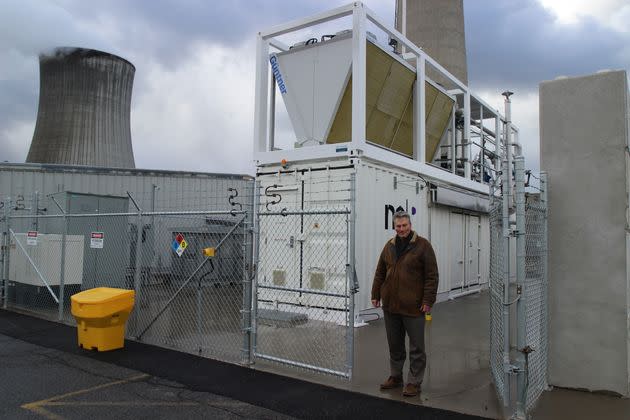
Robert Beaumont, the principal manager for Constellation's hydrogen project at Nine Mile Point, stands in front of the electrolyzer generating the fuel out of zero-carbon atomic electricity.
A leaked draft of Treasury’s proposal suggests that the Biden administration agrees.
Such a rule would effectively bar the nuclear industry from getting in on the hydrogen bonanza. By the time any new reactors could be built — a process that may take more than a decade — the tax credit would expire. Eleven Democrats who also authored the bill — ranging from liberal Sens. John Fetterman (D-Pa.) and Sherrod Brown (D-Ohio) to conservative Sen. Joe Manchin (D-W.Va.) — say the legislation was written specifically to allow for the use of existing nuclear stations and other already-built clean-electricity sources.
It’s not just nuclear operators that want the new-supply requirement nixed. Lobbying alongside Constellation is the Florida-based utility giant NextEra Energy, which operates the largest fleet of renewable power plants in the country, as are trade associations for the hydrogen industry. With some analysts forecasting green hydrogen to stay more expensive than the fossil stuff for decades to come, federal scientists and powerful labor unions say there’s little hope of overcoming the odds if the government makes it too hard for companies to benefit from the tax credit, especially when it notoriously takes years to get new power supply onto the U.S. grid.

Sen. Joe Manchin (D-W.Va.) vehemently opposes forcing companies to build new power plants to be eligible for the Inflation Reduction Act's lucrative green hydrogen tax credit, called 45V.
If the Biden administration moves forward on its proposal, Constellation said it would cancel its plans to produce more hydrogen. It would also sue. Manchin, the powerful head of the Senate’s energy committee, said the White House is misinterpreting the statute and vowed to throw his weight behind a lawsuit.
“We are fighting it,” Manchin told Bloomberg last week, calling the concept of requiring new electricity supply “horrible” and overly restrictive.
The Biden administration did not respond to a request for comment.
Why Getting Clean Hydrogen Right Matters
This, as Heatmap writer Emily Pontecorvo recently wrote, is about much more than hydrogen. It boils down to: “How do you prove your electricity is clean?”
Weaning off oil and gas depends on replacing internal combustion engines in cars and furnaces in basements with battery-electric vehicles and heat pumps that warm homes the same way air conditioners cool them.
If those machines are hooked up to a dirty grid, emissions don’t go away; they just move from one sector to another. That might not be too big a deal as long as the grid keeps getting cleaner over time. For example, the International Council on Clean Transportation found that a midsize electric sedan will still add nearly 70% less carbon to the atmosphere over its lifetime than a comparable combustion-engine car, even when factoring in how much energy is wasted as electricity travels across transmission lines and during battery charging.
Plugging into an electricity source doesn’t, however, work for everything currently powered with fossil fuels. Steelmaking requires reaching temperatures too hot for an electric battery. Batteries big enough to power a commercial airline would also likely make the craft too heavy to go far. The same may be true of long-haul trucking. For applications like these, hydrogen — which, like fossil fuels, releases energy when burned — is widely considered among the most promising climate-friendly solutions.
Batteries also lose charge over time, making the existing technology unreliable for long-term energy storage. Hydrogen, by contrast, maintains its energy while it sits in a tank.
But getting the hydrogen into storage in the first place requires far more energy than the fuel itself will contain, due to how much power is lost in the conversion process. Large-scale electrolyzers will guzzle electricity.
“Getting rid of the requirement for new supply is as bad or worse for emissions as continuing to produce hydrogen from fossil methane,” said Jesse Jenkins, the Princeton University energy systems modeler whose research laid the groundwork for the climate spending law. “It’d be taking us backward from a climate perspective at a time when we’re supposed to be moving forward rapidly.”
Americans’ demand for electricity sank for decades, as factories moved overseas and more efficient new appliances replaced old ones. But that demand is tacking upward again. Among the biggest sources of new demand are data centers powering the digital “mining” of cryptocurrencies like bitcoin, whose hunger for more electricity has helped coal and gas plants stay open or even reopen.
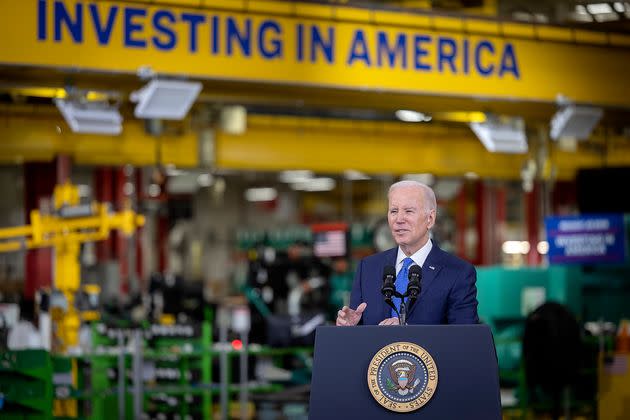
President Joe Biden visits the Cummins Power Generation Facility, which is spending $10 million on electrolyzers, as part of his administration's Investing in America tour, in Fridley, Minnesota, on April 3, 2023.
To avoid the same effect from giant facilities producing hydrogen, the European Union adopted a methodology for determining whether hydrogen is green that depends on three pillars.
The first is geographical — deciding if the hydrogen was generated close enough to clean-energy power sources to qualify. The second is temporal — deciding if the hydrogen was generated during a time period when the grid was mostly powered by clean sources.
The third and most significant step — referred to as “additionality” — requires that a hydrogen producer hoping to cash in on a tax credit bought electricity from a new zero-carbon power plant that would not otherwise be selling power to the grid.
“If you were running off-grid on a new wind and solar farm with batteries, you would know physically you’re 100% clean. But when you’re connected to the grid, all the electrons, all the energy that flows onto the grid, goes based on physics to the path of least impedance,” Jenkins said. “The only way to show you’re a clean grid-connected resource is, whenever you’re consuming power, somebody is generating clean power from a new resource that wouldn’t have otherwise been there.”
If nuclear reactors get an exemption, he said, existing wind and solar plants will likely get one, too. The more clean electricity siphoned away from the grid to generate hydrogen, Jenkins said, the more demand for fossil-fueled power plants to make up the difference.
That’s what’s happened in places like New York and California and overseas in Germany and Taiwan, where fossil fuels compensated for nuclear reactors that shut down. Paying atomic power stations to produce hydrogen instead of electricity for the grid would have the same effect, Jenkins said.
“We need these nuclear plants to stay on the grid producing clean energy so they’re our foundation to build on as we decarbonize the rest of the grid,” he said by phone last week, noting that he advocated early on for state and federal subsidies to keep nuclear plants open. “The exact same reasons to support those policies are the same reasons to be concerned about diverting all this existing nuclear to clean hydrogen.”
But that logic assumes gas-fired power plants will remain the cheapest and most attractive alternative to nuclear power, said Benton Arnett, the senior director of markets and policy at the Nuclear Energy Institute, an industry group. He said it also creates a warped incentive for power plant owners to prematurely tear down wind and solar farms before the end of their 25-year lifespan.
“In terms of net emissions, we may end up worse off and we’re wasting capital building stuff that’s already made,” he said.
Arnett challenged the legal grounds for excluding existing nuclear plants from the hydrogen handouts. Language in the IRA specifically allows companies to “stack” tax credits. That indicates nuclear plants are meant to be able to claim both the law’s 45U credit for generating atomic power and the 45V credit for using those same reactors to make hydrogen.
He pointed to other hydrogen-related proposals from the Biden administration. A footnote in the Environmental Protection Agency’s proposed regulation to curb greenhouse gas emissions from power plants notes that using electrolyzers hooked up to the grid today may end up generating dirtier hydrogen than a producer using the traditional fossil method. But that “concern is likely to be mitigated over time as the carbon intensity of the grid declines,” the agency concluded.
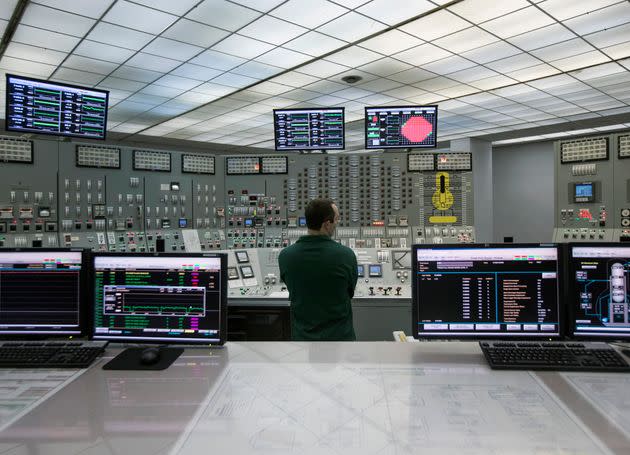
In this Nov. 29, 2016, photo, reactor operator Patrick Ryan works in a control room at Nine Mile Point in Oswego, New York.
Last year, when the Energy Department invited companies to bid to join the hydrogen hubs that the administration was setting up under the Bipartisan Infrastructure Law, the solicitation encouraged applicants to “leverage existing facilities and infrastructure for hydrogen production, storage, delivery, and end-uses” to “maximize the impact of available funding.”
“Any guidance that goes off of that, we think, is in contradiction to the law,” Arnett said.
The European Example
Europe will offer a key test for the green hydrogen industry. Before the European Union set its own additionality requirement in its hydrogen rulebook, skeptics warned that the policy would blunt investments into electrolyzers. But within days of the bloc unveiling its regulations, major projects announced plans to move forward.
France, which has generated the majority of its electricity from nuclear fission for decades, fought hard for a special carve-out allowing its hydrogen producers to benefit from EU incentives. But those particular loopholes have only made an already complicated law more difficult to navigate.
“We like the IRA,” Sanjiv Lamba, chief executive of Ireland-based hydrogen producer Linde Group, recently said, noting that the American law is simpler and easier to understand than the EU’s policies.
In Europe, “we fail to attract our own companies because it’s all too complex,” Jorgo Chatzimarkakis, chief executive of the trade group Hydrogen Europe and one of the continent’s most influential lobbyists, told Politico.
The European incentives are also geared toward stimulating demand for green hydrogen. By contrast, the U.S. government is spending money to increase the total supply. That dynamic could make Europe an attractive export market for American hydrogen producers looking to follow the natural gas industry’s present-day example of selling fuel fracked in Texas and Pennsylvania to Europeans scrambling for alternatives to Russian gas.
If U.S. hydrogen producers cannot prove that their fuel is actually green, it may raise the price. In 2026, the EU will begin imposing a carbon tariff on imports, charging companies seeking to sell to the European market higher fees for dirtier stuff. And the bloc is already looking for hydrogen suppliers overseas.
In June, European Commission President Ursula von der Leyen made a deal with Brazil’s president, Luiz Inácio Lula da Silva, in Brasília to invest nearly $2.2 billion into the Latin American giant’s green hydrogen industry. Last month, Eletrobras Eletronuclear, Brazil’s state-owned nuclear company, said it would start making hydrogen.
Even if a new-supply rule knocks “a few percentage points” off the U.S. hydrogen industry’s immediate growth rate, “you might gain multiples of by unlocking international markets for U.S.-based exports,” said Gniewomir Flis, a hydrogen expert and senior adviser to Kaya Partners, a climate policy consultancy based in London and in Copenhagen, Denmark.
“At the end of the day,” Flis said, “I think it’s very much in the interest of the U.S.”
Divided Industry, United Labor
The industrial companies set to compete for the 45V tax credit are split on how strict the Biden administration should make its rulebook.
“If the goal is to scale clean hydrogen, we should be exploring ways to encourage its production, not creating new hurdles before it can even get off the ground,” Katrina Fritz, executive director of the California Hydrogen Business Council, wrote in a recent op-ed for a trade publication.
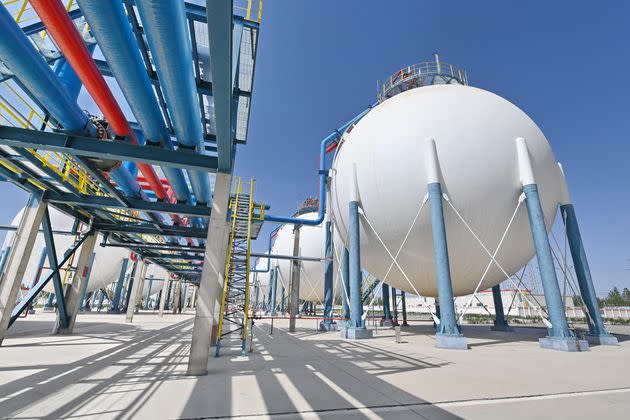
A view of hydrogen storage tanks at the so-called mega green hydrogen plant on Aug. 30, 2023, in the Chinese city of Kuqa, Xinjiang. The facility is China's largest solar-power hydrogen producer.
Requiring hydrogen producers to invest in new electricity generation was unreasonable, according to the head of BP’s U.S. hydrogen division.
“If you want to get the industry off the ground, you’ve got to be reasonable about what it’s going to take,” Tomeka McLeod, the British oil giant’s U.S. vice president for hydrogen, said at an industry conference in Washington earlier this year. “Being super restrictive is definitely not going to be the thing that is going to underpin that.”
Speaking at a separate panel session of the same Hydrogen Americas Summit, Sheldon Kimber, chief executive of the renewables and hydrogen developer Intersect Power, said the stricter rules are not “unreasonable.” That’s particularly so, he said, if — as the leaked draft from last week suggests — the Biden administration is planning to include a grandfathering clause that allows early projects to circumvent certain regulations that can slow down the building process.
“Let’s say you’ve got 2027 as the cut-off for when you commence construction: you can build something that comes on line in 2030 and you’ve got a ten-year grandfathering in the [production tax] credit,” Kimber said, according to a transcript from the trade publication Hydrogen Insight.
“By 2040 you can still be producing clean hydrogen from [power] that you bought from a wind farm in the Dakotas, with coal-power in Georgia,” he added. “Come on, let’s just be honest about that. That’s not what is going to save the climate. That’s not really where we’re headed. You’ve got to pass the sniff test in terms of real decarbonisation.”
Obviously we’ve been in the hydrogen business for over 65 years, while most of the companies talking about this have not produced any hydrogen in their entire histories. So it’s a little like me telling someone how to fly a plane.Eric Guter, vice president at Air Products and Chemicals Inc.
Air Products and Chemicals Inc., the world’s largest hydrogen producer, has “been a staunch advocate” of strict tax credit rules “since day one,” said company Vice President Eric Guter.
“This is being funded through taxpayer money. It’s important we have the full faith and confidence to know emissions are actually reduced,” he said by phone last week. “With the entire energy transition globally, we need to harmonize the certification schemes, and Europe has already made clear” that it was going to require new supply, he added.
Hoping to meet that future demand, the Allentown, Pennsylvania-based firm has already announced a combined $15 billion in investments into new projects, split roughly evenly between green and blue hydrogen.
By 2030, the energy consultancy BloombergNEF forecasts that green hydrogen made from a new plant could be as much as 18% cheaper than continuing to run an existing gray hydrogen plant in Brazil, China, India, Spain and Sweden.
“Remarkably, this holds true even for green hydrogen plants built without subsidies,” Adithya Bhashyam, a hydrogen analyst at BloombergNEF, wrote in a recent client memo.
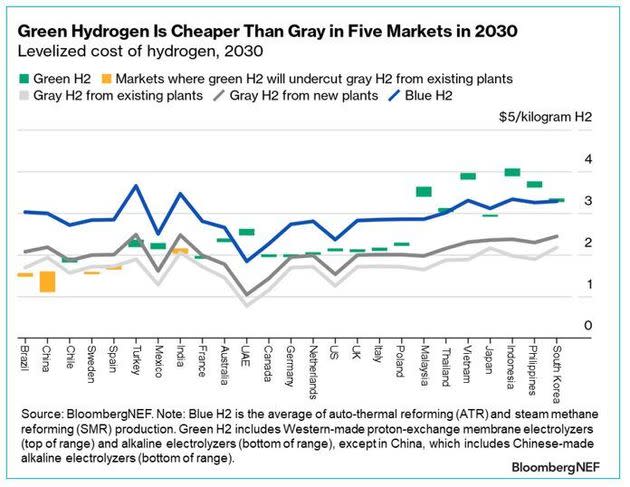
A chart from a public BloombergNEF report shows green hydrogen prices falling below those of traditional gray hydrogen by the end of this decade, though nowhere near the $1 per kilogram figure the Biden administration is targeting.
Given that global trajectory, Guter accused doomsayers demanding lower barriers to entering his industry of not understanding the changing economics of hydrogen.
“Obviously we’ve been in the hydrogen business for over 65 years, while most of the companies talking about this have not produced any hydrogen in their entire histories,” he said. “So it’s a little like me telling someone how to fly a plane. I’d have no business doing that.”
The labor unions angling for jobs building out the hydrogen economy, on the other hand, are largely united against stricter rules.
The nation’s largest unions representing laborers, carpenters, electricians and pipe fitters allsentletters to the U.S. administration urging it to drop the additionality requirement.
North America’s Building Trades Unions complained that even the more widely accepted provision to limit hydrogen production to times when the grid is flush with clean electricity would directly “stifle the creation of good union jobs” and “hamstring the greening of our grid.”
No Obvious Atomic Loopholes
On Wednesday afternoon, thick snowflakes whipped off Lake Ontario’s waves and coated Robert Beaumont’s puffy coat as he cranked open the door to the shipping container to give a reporter a tour of Nine Mile Point’s electrolyzer operation. Squeezing into the narrow structure, past twisting silver pipes and ducts, the Constellation project manager explained how the electrolyzer blasts molecules of highly purified water from Oswego’s municipal water supply apart with nearly 14,000 volts of electricity, and filters the hydrogen through stacks of polymer-membrane cells.
“Before this, no one could do what we’re doing here on this scale,” Beaumont said. “It’s very satisfying for me.”
Like many other former U.S. Navy submariners, Beaumont turned what he learned serving on nuclear-powered vessels into a career in civilian atomic energy. Submarines similarly use electrolyzers but in reverse, zapping seawater with electricity to harvest oxygen for sailors to breathe during long voyages underwater. Pairing the machines with nuclear power just makes sense, he said.
All sources of zero-emissions electricity should be realized to meet our hydrogen goals. Just using limited sources, I think, will not achieve the full-scale hydrogen economy we are seeking.Jess C. Gehin, Idaho National Laboratory
There are ways that existing nuclear plants could potentially qualify as new supply. If a nuclear operator makes modifications to a reactor to “uprate” the machine and generate more electricity than before, that additional output might qualify as new. Opening the utility’s books to prove that a financially troubled atomic station would have shut down if not used to make hydrogen could also offer a loophole.
But NEI’s Arnett said that the U.S. nuclear industry has already upgraded most of its existing reactors, so there isn’t enough potential new supply to tap to make the numbers on new hydrogen work.
Another potential avenue could come from an entirely new method of producing hydrogen with high-temperature steam, which nuclear reactors create in vast abundance. Far more efficient than using electricity, the technique extracts hydrogen from water nearly as efficiently as today’s dominant natural gas approach. A California manufacturer unveiled a prototype of a high-temperature steam electrolyzer in May. A month earlier, the Minneapolis-based utility Xcel Energy announced plans to begin generating hydrogen at its Prairie Island Nuclear Generating Station in Minnesota using the high-temperature steam method.
It’s no simple solution. Rerouting steam away from a reactor is a huge engineering undertaking that risks reducing a nuclear plant’s electrical output, Beaumont said.
“It’s still not as complicated as building a whole new plant,” he said with a laugh.
If nuclear operators already lose ground to other energy sources in the hydrogen industry, “it would likely mute or not encourage” the kind of investment needed to bring more cutting-edge technologies to market, said Jess C. Gehin, the associate lab director for nuclear science at the Idaho National Laboratory.
“All sources of zero-emissions electricity should be realized to meet our hydrogen goals,” Gehin said by phone last week. “Just using limited sources, I think, will not achieve the full-scale hydrogen economy we are seeking.”
At scale, clean hydrogen could feed crops, heat iron into steel, and fuel diesel trucks too big and heavy for batteries, like the hulking dumpers plowing Oswego’s quiet country roads. As snow fell down on cozy-looking farmhouses and trailer parks with twinkling Christmas lights, the trucks belched thick plumes of black diesel soot upward.
